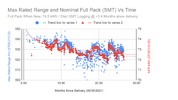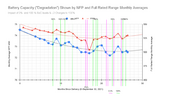Do you own this car because most owners should have noticed an increase in range right away. Other than that I see no reason why someone would say they didn't receive the update.
No I don't. However, there are a lot of reasons why people would not notice this change.
Actually I've figured this out before, but what I said above is
wrong.
Specifically this is wrong:
haven’t seen any TeslaFi captures showing no change to range on the update. (Everyone should have seen a change - some people would go from 295 to 310 for example.)
This 295 to 310 could NOT happen. If below 310miles before the update,
people would not see any change when making the update!
Most likely (since the LR RWD always had over 330 miles in the EPA test), Tesla just had the degradation threshold set to 310 miles, from the beginning. This means that people with LR RWD happily had 310 miles until their capacity dropped below 310mi*234Wh/mi = 72.5kWh (takes a year or more in some cases).
Most vehicles were still above 72.5kWh when the update came along in less than a year after the vehicle release. Maybe some had started to show a little capacity loss, for example 72kWh would give 308 miles.
But when the update came along, anyone above 72.5kWh would have seen their max range go up a bit. Maybe from 310 to 315, for example, if their car was a year old with 73.7kWh estimate.
Anyway, net result is some people would see basically no change with the update. Many would see very little change. (They might see 315 and think they "didn't get the update."). People with the oldest most degraded vehicles, below 72.5kWh, would see no change!
Furthermore, many would not be paying attention to their 100% charge, and only pay attention after the update. So it would be hard to see the change.
Would have to search out TeslaFi captures of a person before and after the update to see whether what I am saying is consistent.
This is my best guess of what happened. I am quite confident that the constant did NOT change on this update, based on discussions at the time with owners where I asked this specific question. I think the rated line has always been at 239Wh/mi (234Wh/mi constant). Before and after update.
(As a refresher on degradation threshold: Remember that the way it works is it crams all the energy into the available miles, so if you are above the threshold, your miles will be more energetic. For example, if you have 78kWh with a 72.5kWh/310mi degradation threshold, each rated mile will contain 252Wh (78kWh/310mi), while after you get to 72.5kWh, you'll get 234Wh per mile. And below that you'll just start losing rated miles. So it's not really like a top buffer where when you start driving you won't see any change in your miles until you get below 72.5kWh of remaining energy. It's a top buffer of sorts, but it doesn't work that way. Miles start clicking off as soon as you start driving. Just more slowly than they would for someone in a car below the threshold.)





